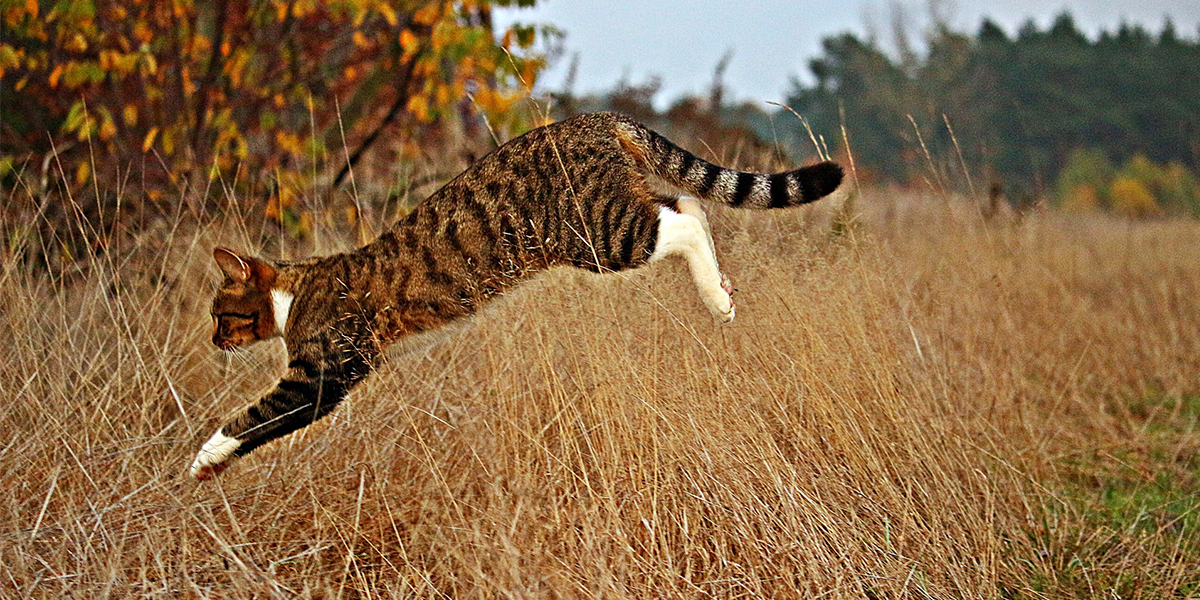Understanding house cat behavior is essential for establishing a perfect connection with your feline companion. In order to develop a strong bond, it is important to comprehend their behaviors and instincts.
By observing their body language, vocalizations, and social interactions, you can learn to interpret their needs and emotions. Creating a stimulating environment, providing proper care, and engaging in interactive play sessions will help you build a harmonious relationship with your cat.
Whether it’s understanding their predatory instincts or respecting their need for personal space, a deep understanding of cat behavior is vital for a strong and fulfilling human-cat connection

Credit: www.helpguide.org
Common House Cat Behaviors
Understanding the behavior of your house cat is key to establishing a strong and loving bond with your feline friend. Cats exhibit a range of behaviors that are both instinctual and learned. By recognizing and interpreting these behaviors, you can better meet your cat’s needs and enhance your connection with them.
Establishing Territory
Cats have a strong instinct to establish and defend their territory. Whether they live in a sprawling house or a compact apartment, cats mark their territory in various ways. They may rub their scent glands on furniture and walls, leaving their unique scent behind as a way of claiming ownership. This behavior allows them to feel secure and establishes boundaries within their environment.
Marking And Scratching
Marking and scratching are common behaviors in house cats. By scratching surfaces, cats not only groom their claws but also visually and olfactorily mark their territory. It’s important to provide appropriate scratching posts and surfaces to redirect this behavior and protect your furniture. Additionally, cats may engage in urine marking as a way of communicating with other cats and asserting their dominance.
Hunting And Stalking
Cats are natural hunters, and even though they may no longer need to catch their own food, hunting and stalking behaviors are deeply ingrained in their DNA. You might observe your cat crouching low, twitching their tail, and pouncing on toys or imaginary prey. Providing interactive toys and engaging in play sessions can help satisfy their natural hunting instincts.
Playful Behavior
Playfulness is an essential part of a cat’s behavior. From chasing objects to pouncing, rolling, and leaping, cats engage in play as a means of exercise and mental stimulation. Bonding with your cat through play can strengthen your relationship and provide them with much-needed physical and mental stimulation. Remember to provide a variety of toys and rotate them periodically to keep playtime engaging.
Soothing Behaviors
Cats have soothing behaviors that bring them comfort and relaxation. Grooming, for example, not only helps keep their fur clean but also releases endorphins that make them feel content. You may notice your cat licking themselves or other cats in their social group. Purring is another common soothing behavior that signifies their contentment and can also serve as a form of communication with their humans.

Credit: www.thepuppyacademy.com
Creating A Connection With Your Cat
Creating a strong bond with your furry companion can be a truly rewarding experience. Whether you’ve recently brought home a new cat or you’re looking to deepen your connection with your current feline friend, understanding house cat behavior is crucial. By taking the time to decode their body language, providing enrichment, establishing trust and bonding, implementing positive reinforcement training, and maintaining a routine, you can establish a perfect connection with your cat.Understanding Body Language
Understanding your cat’s body language is key to strengthening your connection. Cats communicate through their body postures, tail positions, and vocalizations. By observing these cues, you can assess their mood and respond appropriately.
Some common body language signals to look out for include:
- Relaxed body and tail held upright: Indicates contentment and confidence
- Arched back, fur standing on end, and hissing: Signals aggression or fear
- Tail tucked between the legs: Suggests fear or submission
- Purring and kneading: Signifies contentment and relaxation
Providing Enrichment
Enriching your cat’s environment is crucial for their physical and mental well-being, which in turn strengthens your bond. Cats are natural hunters and enjoy engaging their instincts. Provide them with interactive toys, scratching posts, and puzzle feeders to keep their minds stimulated and promote exercise. Additionally, setting up perches or window shelves allows them to observe their surroundings and satisfy their curiosity.
Establishing Trust And Bonding
Building trust with your cat is the foundation of a strong connection. Take it slow and let them approach you on their terms. Offer gentle pets, and as they become comfortable, gradually increase physical contact. Respect their boundaries by avoiding sudden movements or loud noises that may startle them. Spending quality time together, such as playing or grooming, reinforces the bond between you and solidifies trust.
Positive Reinforcement Training
Using positive reinforcement techniques is an effective way to foster good behavior and strengthen your connection with your cat. Reward desired behaviors, such as using their litter box or scratching the appropriate surfaces, with treats or praise. Avoid punishment-based methods, as they can damage your relationship and lead to fear or aggression. Consistency and patience are key when implementing positive reinforcement training.
Maintaining A Routine
Cats are creatures of habit, and maintaining a consistent routine is important for their overall well-being. Feed them at the same time each day, clean their litter box regularly, and establish a consistent playtime schedule. Adjustments to their routine should be made gradually to avoid causing stress or anxiety. By providing a predictable environment, your cat will feel more secure and connected to you.
Addressing Undesirable Behaviors
Understanding house cat behavior is key to building a strong and rewarding connection with our feline companions. However, there may be times when our cats exhibit undesirable behaviors that can be frustrating and challenging to address. This section focuses on several common issues—aggression, destructive scratching, inappropriate elimination, excessive vocalization, and fear and anxiety—and provides helpful tips to tackle these problems effectively.
Aggression
Aggression in cats can manifest as hissing, growling, biting, or scratching. It is important to remember that aggression is usually a result of fear, stress, or frustration. To address aggression:
- Identify and remove potential triggers or stressors from your cat’s environment.
- Provide your cat with a safe space, such as a separate room or elevated perch, where they can retreat and feel secure.
- Engage your cat in interactive play sessions using toys that mimic prey, redirecting their energy towards appropriate outlets.
- Consider the use of calming pheromone diffusers or consulting with a veterinarian or animal behaviorist for additional guidance.
Destructive Scratching
Destructive scratching is a natural behavior for cats, but it can become problematic when furniture, carpets, or curtains become the target. To discourage destructive scratching:
- Provide your cat with appropriate scratching surfaces, such as scratching posts or mats, placed near the areas that they tend to scratch.
- Ensure the scratching surfaces are appealing by sprinkling them with catnip or using cat-friendly pheromone sprays.
- Redirect your cat’s attention to the appropriate scratching surfaces by gently guiding their paws and praising them when they use them.
- Trim your cat’s nails regularly and consider using soft nail caps to minimize the damage caused by scratching.
Inappropriate Elimination
Inappropriate elimination, such as urinating or defecating outside the litter box, can be a sign of an underlying medical or behavioral issue. To tackle this problem:
- Ensure your cat’s litter box is clean, easily accessible, and located in a quiet and private area.
- Consider providing multiple litter boxes, especially in multi-cat households, to reduce competition and stress.
- Rule out any medical conditions by consulting with a veterinarian.
- Clean any soiled areas thoroughly with enzymatic cleaners to remove the odor, as cats are sensitive to scent markings.
- Provide environmental enrichment, such as vertical spaces and interactive toys, to alleviate boredom and ensure mental stimulation.
Excessive Vocalization
If your cat vocalizes excessively, it can be a sign of attention-seeking, stress, or medical issues. To address excessive vocalization:
- Ensure your cat’s needs are met by providing regular play sessions, feeding schedules, and affectionate interactions.
- Consult with a veterinarian to rule out any underlying medical conditions.
- Create a quiet and calm environment for your cat, minimizing potential triggers or stressors.
- Offer interactive toys and mental stimulation to keep your cat occupied and engaged.
Fear And Anxiety
Fear and anxiety can cause a range of problematic behaviors in cats, such as hiding, avoidance, or aggression. To help your cat cope with fear and anxiety:
- Create a safe and enriched environment that offers hiding spots, vertical spaces, and comforting resources like cozy beds or blankets.
- Refrain from forcing interactions and allow your cat to approach you gradually on their terms.
- Consider the use of pheromone diffusers or natural calming remedies after consulting with a veterinarian.
- Provide positive associations with fearful situations by using treats or play as a distraction.
- If severe anxiety persists, consult with a veterinarian or animal behaviorist for a comprehensive behavior modification plan.

Credit: www.armandhammer.com
Solving Behavior Issues
Understanding House Cat Behavior: Tips for a Perfect Connection helps in solving behavior issues by providing valuable insights into cat behavior, enabling pet owners to establish a strong bond with their furry companions. Discover effective strategies to address behavior problems, leading to a harmonious relationship.
Identifying The Underlying Cause
When faced with behavior issues, it is crucial to identify the underlying cause. House cats may display undesirable behaviors such as aggression, urine marking, or excessive meowing, which can be symptoms of deeper issues. By identifying the root cause, we can tailor our approach to effectively address the problem.
Seeking Professional Help
If you find it challenging to determine the cause of your cat’s behavior issues or if the problems persist despite your efforts, seeking professional help is strongly recommended. Veterinarians or animal behaviorists have the expertise to assess and diagnose the root causes, providing you with appropriate guidance and treatment plans.
Implementing Behavior Modification Techniques
Once the underlying cause is identified, implementing behavior modification techniques becomes vital for resolving the issues. Whether it’s redirecting inappropriate scratching to appropriate scratching posts or using positive reinforcement to discourage aggressive behavior, consistency and patience are key in modifying your cat’s behavior.
Creating A Safe Environment
A safe environment is crucial in preventing and resolving behavior issues. Cats need an environment that fulfills their natural instincts, such as providing vertical spaces for climbing, hiding spots, and interactive toys. Creating a safe and stimulating environment not only reduces stress but also promotes positive behaviors.
Using Recommended Products
To enhance your cat’s well-being and assist in behavior modification, there are various recommended products available on the market. These include interactive puzzle feeders to keep your cat mentally stimulated, calming pheromone diffusers to reduce anxiety, and scratching posts to redirect their natural scratching tendencies.
Building A Healthy And Happy Environment
Building a healthy and happy environment is crucial for understanding house cat behavior and fostering a strong connection with your feline friend. By providing the right environment, you can ensure that your cat feels safe, secure, and content in their surroundings. Here are some essential factors to consider:
Proper Nutrition And Mealtime
Feeding your cat a well-balanced diet is essential for their overall health and well-being. Ensure that you offer high-quality cat food that meets their specific nutritional needs. Consult with your veterinarian to determine the appropriate portion sizes and feeding schedule. Provide fresh water at all times to keep your cat hydrated.
Exercise And Playtime
Cats are natural hunters and are prone to boredom if they don’t have enough physical and mental stimulation. Engage your cat in regular play sessions using interactive toys to keep them active and entertained. Set aside designated playtime each day to bond with your furry companion.
Social Interaction With Humans And Other Animals
Cats are social creatures and thrive on human companionship. Make sure you spend quality time with your cat, offering affection, and engaging in gentle interactions. Additionally, consider introducing your cat to other friendly animals, if possible, to provide socialization opportunities. Monitor their interactions closely to ensure everyone’s safety and comfort.
Access To Adequate Resting Areas
Cats love their sleep, and it’s essential to provide them with comfortable resting areas. Consider providing cozy cat beds, soft blankets, or even cat trees and shelves where they can relax and observe their surroundings. Having multiple resting areas in various parts of your home allows your cat to choose their preferred spot.
Regular Veterinary Check-ups
Regular visits to the veterinarian are vital to ensure your cat’s ongoing health and to catch any potential issues early. Schedule routine check-ups and vaccinations to keep your cat protected from common diseases. Your vet can also provide advice on preventive measures, such as flea and tick control, dental care, and appropriate grooming techniques.
Frequently Asked Questions For Understanding House Cat Behavior: Tips For A Perfect Connection
How Do You Build A Connection With A Cat?
To build a connection with a cat: interact regularly, offer gentle strokes and rubs, use positive reinforcement with treats or toys, spend quality time playing together, and respect their boundaries and personal space.
How Do I Have A Good Relationship With My Cat?
To have a good relationship with your cat, spend quality time together. Play and provide toys to keep your cat entertained. Gently pet and groom your cat to show love and care. Avoid loud noises or sudden movements that may startle your cat.
Always provide a safe and comfortable environment for your cat to feel secure.
How Do I Bond With My Cat The Best?
To bond with your cat, spend quality time playing, petting, and grooming them every day. Use positive reinforcement techniques, like treats and praise, to reward good behavior. Create a safe and comfortable environment for your cat. Respect their boundaries and provide plenty of love and attention.
How Do House Cats Show Love?
House cats show love through gentle purring, rubbing against you, kneading their paws, licking, and slow blinking.
Conclusion
Understanding house cat behavior is key to building a strong bond with your feline companion. By recognizing their natural instincts, communication cues, and social needs, you can create a perfect connection with your cat. From providing a safe environment to engaging in interactive play, these tips will help you foster a happy and healthy relationship with your furry friend.
Embrace the opportunity to understand your cat’s behavior and watch your connection flourish. Together, you and your cat can create a harmonious and fulfilling bond that will last a lifetime.

